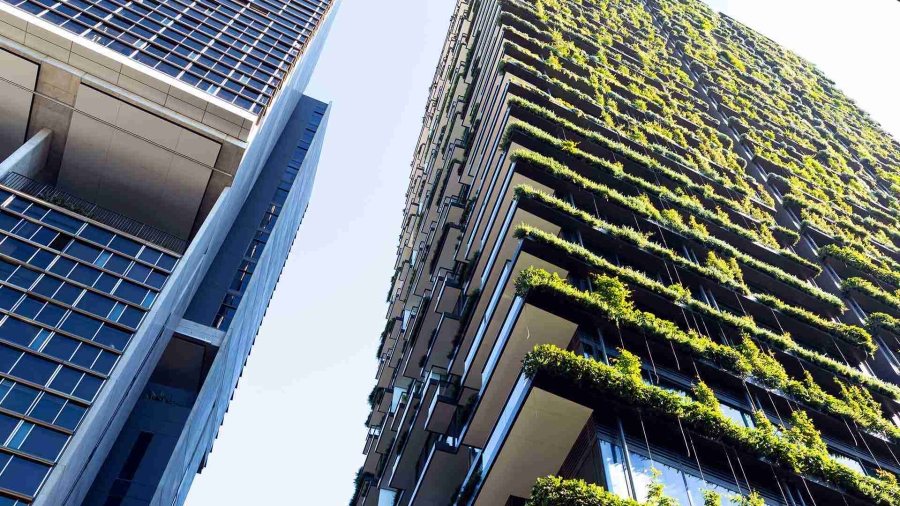- Buildings account for 37% of the world’s carbon emissions; fortunately, technologies to dramatically reduce energy consumption in buildings already exist.
- Yet many building owners, operators, developers, and financiers are still not fully aware of the many solutions that exist, or of the value and investment returns created by embedding them.
- To improve awareness, Schneider Electric, alongside Accenture and the World Economic Forum, developed a Building Value Framework.
Against the backdrop of the French Alps sits a 26,000-square-meter office building, a space where over 1,500 workers come together daily. Two towering wind turbines and a sea of solar panels lining the roof generate all the energy the building needs. On the inside, sensors and software optimize lighting, heating, cooling, and other energy-consuming activities, ensuring no power is wasted.
In fact, this new building may just be the best example of building energy efficiency in the world. That’s according to the LEED Certification International Framework, which rates how sustainable buildings are. Achieving net-zero emissions annually, it uses only one-tenth of the energy of its average European counterpart.
Getting more buildings to embed these sorts of technologies is crucial if we’re to avert calamitous climate change. Whether they’re the malls we shop in, the homes we live in, the factories and office buildings we work in, or the hospitals, transport hubs, and schools we visit, buildings account for 37% of the world’s carbon emissions.
Add to that the recent spike in energy prices – now at multi-decade highs – and it’s clear that reducing energy usage through greater efficiency is now imperative for businesses, policymakers and households everywhere.
Rethinking the value of buildings: Beyond financials
The good news is that the technologies to dramatically reduce energy consumption in buildings already exist. And it makes not just environmental but also social and financial sense to incorporate them in new buildings – or to add them to existing ones. The investment cost of decarbonizing and digitizing that office building in the French Alps, for example, will be recouped within the next three to five years.
And then there are the non-financial benefits. Investing in low-carbon, efficient buildings and cities brings greater energy resilience; it creates jobs; and it means improved health and well-being for those who live and work in them.
Raising awareness of the possibilities: A framework for action
Yet many building owners, operators, developers, and financiers are still not fully aware of the many solutions that already exist, or of the value and investment returns that are created by embedding them into new or existing buildings.
To improve awareness, and help decision-makers – from end users to real estate owners – better evaluate such investments, Schneider Electric, alongside Accenture and the World Economic Forum, in 2022 developed a Building Value Framework.
Part of the wider Net Zero Carbon Cities initiative includes a practical operational checklist spanning a set of recommendations to future-proof building investments – whatever the building’s size, use, or geographic location.
The starting point: The decarbonized, smart building
It all starts with decarbonizing and digitizing individual buildings.
On the decarbonization front, the most obvious action point is to avoid the use of fossil fuels (heating with oil or coal, for example, or cooking with gas), and use electric alternatives instead. Electricity is not only more efficient (less energy wasted) but also cleaner (less carbon released into the atmosphere).
But it’s also about equipping buildings with the means to generate their own clean energy. Think the solar panels and wind turbines that supply the power for that building in France: these are proven technologies whose cost has fallen dramatically in recent years, and that any building owner or operator can and should consider.
On the digitization front, building operators can sharply increase energy efficiency via sensors and automation systems that ensure heating, cooling, and lighting are only provided when and where needed. Yes, insulation such as double-glazing improves energy efficiency, but “active” energy management via digital tools is far more cost-effective over time.
Digital tools can also help building managers and tenants better monitor energy consumption, giving them insights on behavioral changes that might improve energy usage. Deploying building management systems on top of this data allows the building to most efficiently use its energy, as well as flagging to building staff and tenants any issues for improvement.
The best results are achieved when all the data – everything from those sensors to the systems running on the ground – is shared into one data pool.
Finally, digital twins can help developers optimize a building’s efficiency right from the get-go – minimizing costs and waste from the design and construction stages, and reaping efficiency benefits right through to the day-to-day operations. In the case of that office building in France, for example, planners incorporated half a million variables into an energy simulation at the outset, to predict how, why, and where energy was going to be used. This allowed them to attain maximum efficiency once the building was actually complete.
Going beyond single buildings: The system effect
Decarbonizing and digitizing individual buildings is just part of the story, however. Even more ideal is when such buildings go one step further – when their energy and resource management capabilities are integrated into the wider power, transport, and EV-charging ecosystems around them. Doing so can help stabilize cities’ energy supplies and accelerate the transition to net-zero.
Again, a concrete example of what this looks like exists: our new office building in France will ultimately be able to feed any surplus energy generated by its wind turbines and solar panels to the neighboring power grid.
The buildings' transition is possible: Make it happen today
Sustainable, resilient, and people-centric buildings are not utopian dreams for the distant future. They exist in the here and now. The office building in the French Alps (Schneider Electric’s newest building) is proof of that.
To address the twin challenges of climate change and soaring energy prices, we need to ensure they’re no longer the exception – that they become commonplace in towns and cities around the globe. It’s not a case of inventing new technologies, but of adopting them, fast. Our simple to-do list is a good place to start.
This article was first published by The World Economic Forum on May 17, 2022.
Follow Jean-Pascal Tricoire on LinkedIn and Twitter, and catch up on his past articles below.
Yes, we can have sustainable cities
Why Energy Efficiency is the Unsung Hero of the Fight Against Climate Change
Corporate action on climate change needed now more than ever
Decarbonizing cities – how to harmonize buildings, mobility and infrastructure














